The Cambridge History of Japan, Vol. 3: Medieval Japan
Подождите немного. Документ загружается.

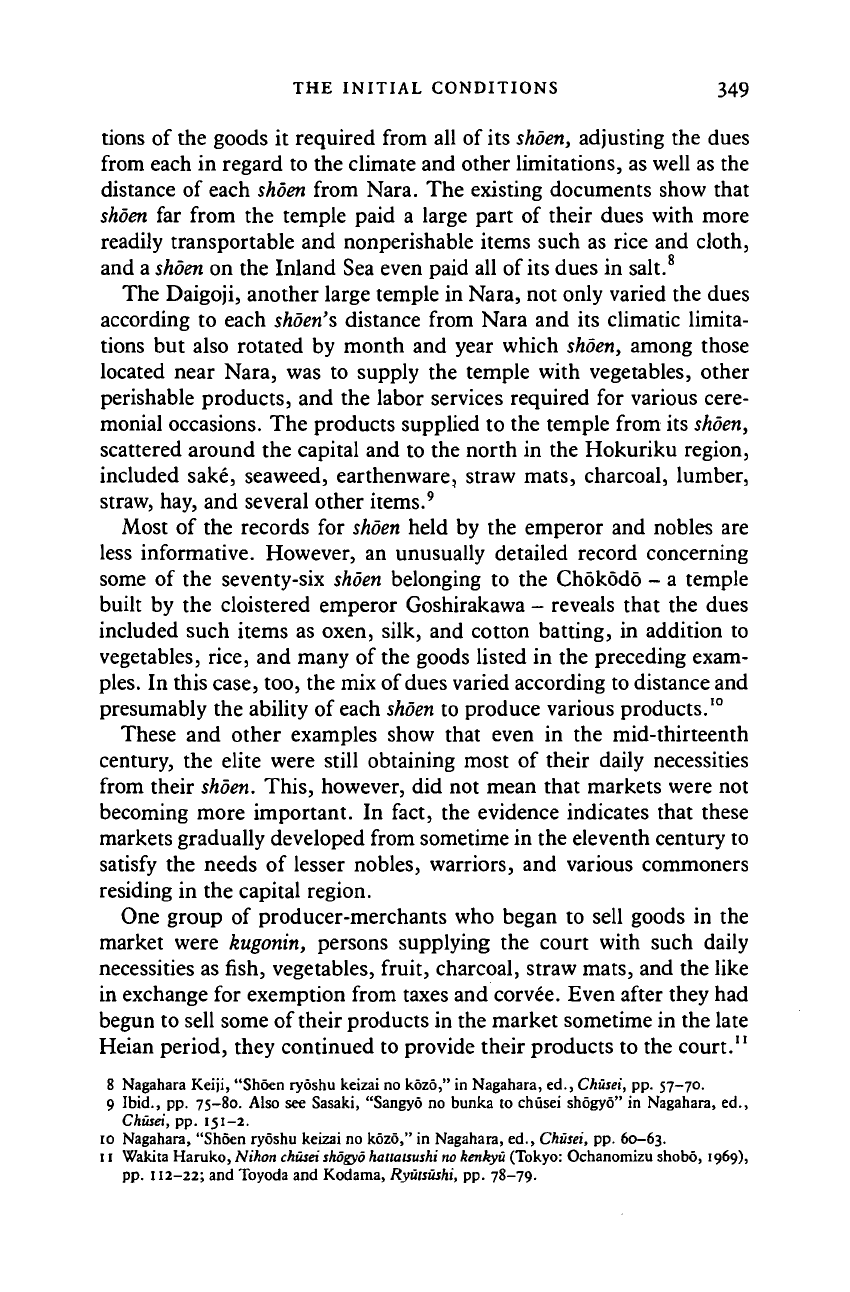
THE INITIAL CONDITIONS 349
tions of the goods it required from all of its shoen, adjusting the dues
from each in regard to the climate and other limitations, as well as the
distance of each shoen from Nara. The existing documents show that
shoen far from the temple paid a large part of their dues with more
readily transportable and nonperishable items such as rice and cloth,
and a
shoen
on the Inland Sea even paid all of its dues in salt.
8
The Daigoji, another large temple in Nara, not only varied the dues
according to each shoen's distance from Nara and its climatic limita-
tions but also rotated by month and year which shoen, among those
located near Nara, was to supply the temple with vegetables, other
perishable products, and the labor services required for various cere-
monial occasions. The products supplied to the temple from its shoen,
scattered around the capital and to the north in the Hokuriku region,
included sake, seaweed, earthenware, straw mats, charcoal, lumber,
straw, hay, and several other items.
9
Most of the records for shoen held by the emperor and nobles are
less informative. However, an unusually detailed record concerning
some of the seventy-six shoen belonging to the Chokodo - a temple
built by the cloistered emperor Goshirakawa - reveals that the dues
included such items as oxen, silk, and cotton batting, in addition to
vegetables, rice, and many of the goods listed in the preceding exam-
ples.
In this case, too, the mix of dues varied according to distance and
presumably the ability of each
shoen
to produce various products.
10
These and other examples show that even in the mid-thirteenth
century, the elite were still obtaining most of their daily necessities
from their shoen. This, however, did not mean that markets were not
becoming more important. In fact, the evidence indicates that these
markets gradually developed from sometime in the eleventh century to
satisfy the needs of lesser nobles, warriors, and various commoners
residing in the capital region.
One group of producer-merchants who began to sell goods in the
market were kugonin, persons supplying the court with such daily
necessities as fish, vegetables, fruit, charcoal, straw mats, and the like
in exchange for exemption from taxes and corvee. Even after they had
begun to sell some of their products in the market sometime in the late
Heian period, they continued to provide their products to the court."
8 Nagahara Keiji, "Shoen ryoshu keizai no kozo," in Nagahara, ed., Chusei, pp. 57-70.
9 Ibid., pp. 75-80. Also see Sasaki, "Sangyo no bunka to chusei shogyo" in Nagahara, ed.,
Chusei, pp. 151-2.
10 Nagahara, "Shoen ryoshu keizai no kozo," in Nagahara, ed., Chusei, pp.
60-63.
11 Wakita Haruko, Nihon
chusei shogyo
hallatsushi
no
kenkyu (Tokyo: Ochanomizu shobo, 1969),
pp.
112-22; and Toyoda and Kodama, Ryutsushi, pp. 78-79.
Cambridge Histories Online © Cambridge University Press, 2008
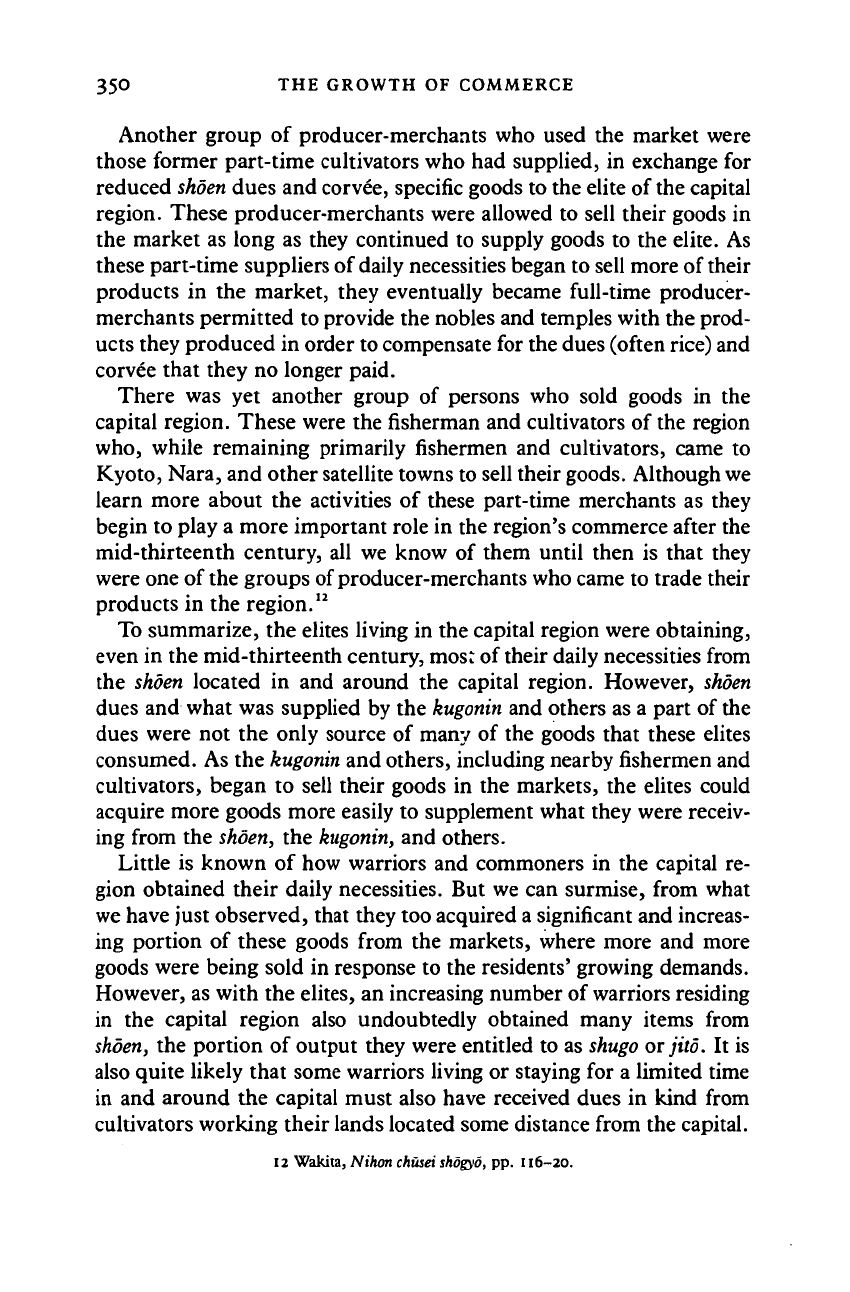
350 THE GROWTH OF COMMERCE
Another group of producer-merchants who used the market were
those former part-time cultivators who had supplied, in exchange for
reduced
shoen
dues and corvee, specific goods to the elite of
the
capital
region. These producer-merchants were allowed to sell their goods in
the market as long as they continued to supply goods to the elite. As
these part-time suppliers of daily necessities began to sell more of their
products in the market, they eventually became full-time producer-
merchants permitted to provide the nobles and temples with the prod-
ucts they produced in order to compensate for the dues (often rice) and
corvee that they no longer paid.
There was yet another group of persons who sold goods in the
capital region. These were the fisherman and cultivators of the region
who,
while remaining primarily fishermen and cultivators, came to
Kyoto, Nara, and other satellite towns to sell their
goods.
Although we
learn more about the activities of these part-time merchants as they
begin to play a more important role in the region's commerce after the
mid-thirteenth century, all we know of them until then is that they
were one of the groups of producer-merchants who came to trade their
products in the region.
12
To summarize, the elites living in the capital region were obtaining,
even in the mid-thirteenth century, most of their daily necessities from
the
shoen
located in and around the capital region. However,
shoen
dues and what was supplied by the
kugonin
and others as a part of the
dues were not the only source of many of the goods that these elites
consumed. As the
kugonin
and others, including nearby fishermen and
cultivators, began to sell their goods in the markets, the elites could
acquire more goods more easily to supplement what they were receiv-
ing from the
shoen,
the
kugonin,
and others.
Little is known of how warriors and commoners in the capital re-
gion obtained their daily necessities. But we can surmise, from what
we have just observed, that they too acquired
a
significant and increas-
ing portion of these goods from the markets, where more and more
goods were being sold in response to the residents' growing demands.
However, as with the elites, an increasing number of warriors residing
in the capital region also undoubtedly obtained many items from
shoen,
the portion of output they were entitled to as
shugo
or
jito.
It is
also quite likely that some warriors living or staying for a limited time
in and around the capital must also have received dues in kind from
cultivators working their lands located some distance from the capital.
12 Wakita, Nihon chusei
shdgyd,
pp. 116-20.
Cambridge Histories Online © Cambridge University Press, 2008
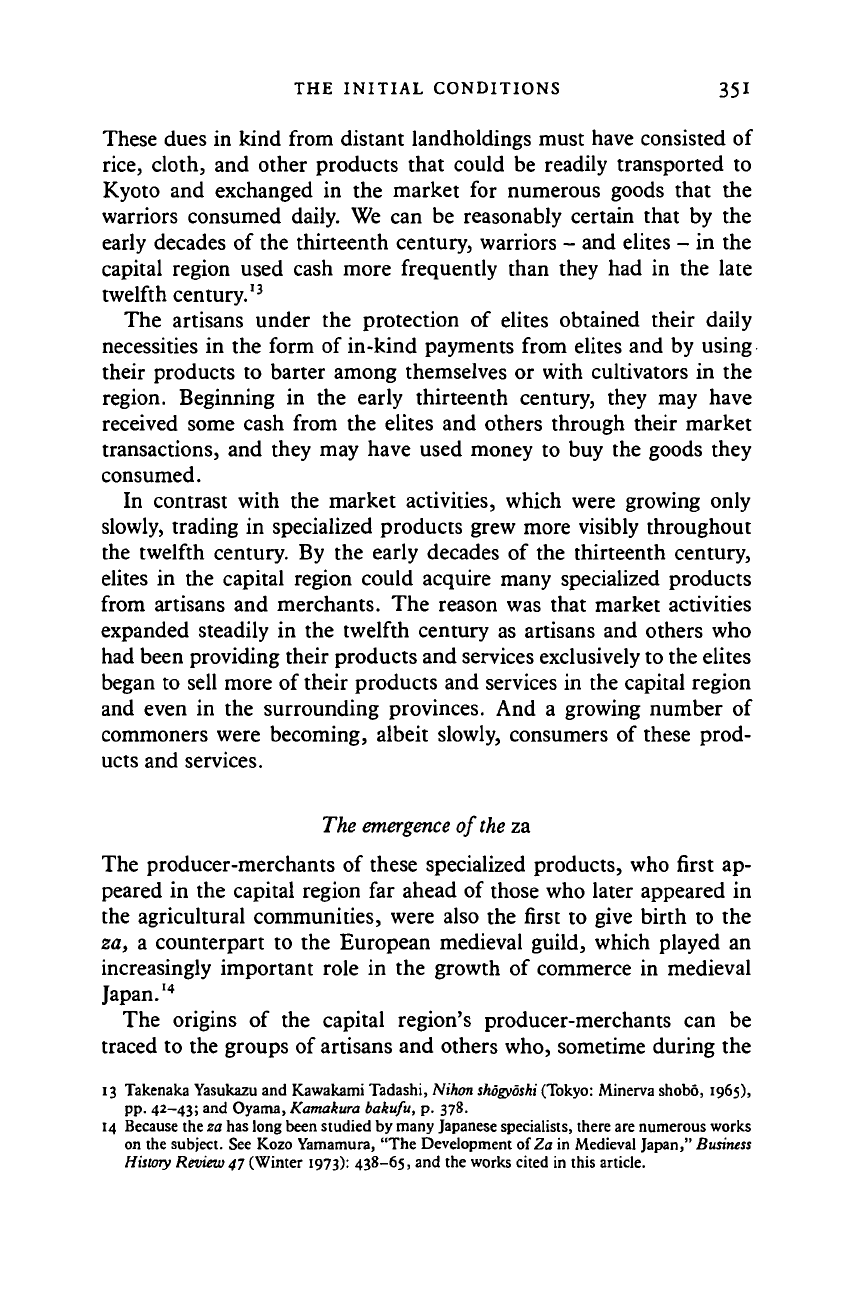
THE INITIAL CONDITIONS 351
These dues in kind from distant landholdings must have consisted of
rice,
cloth, and other products that could be readily transported to
Kyoto and exchanged in the market for numerous goods that the
warriors consumed daily. We can be reasonably certain that by the
early decades of the thirteenth century, warriors - and elites - in the
capital region used cash more frequently than they had in the late
twelfth century.
13
The artisans under the protection of elites obtained their daily
necessities in the form of in-kind payments from elites and by using
their products to barter among themselves or with cultivators in the
region. Beginning in the early thirteenth century, they may have
received some cash from the elites and others through their market
transactions, and they may have used money to buy the goods they
consumed.
In contrast with the market activities, which were growing only
slowly, trading in specialized products grew more visibly throughout
the twelfth century. By the early decades of the thirteenth century,
elites in the capital region could acquire many specialized products
from artisans and merchants. The reason was that market activities
expanded steadily in the twelfth century as artisans and others who
had been providing their products and services exclusively to the elites
began to sell more of their products and services in the capital region
and even in the surrounding provinces. And a growing number of
commoners were becoming, albeit slowly, consumers of these prod-
ucts and services.
The
emergence
of the za
The producer-merchants of these specialized products, who first ap-
peared in the capital region far ahead of those who later appeared in
the agricultural communities, were also the first to give birth to the
za, a counterpart to the European medieval guild, which played an
increasingly important role in the growth of commerce in medieval
Japan.'
4
The origins of the capital region's producer-merchants can be
traced to the groups of artisans and others who, sometime during the
13 Takenaka Yasukazu and Kawakami Tadashi, Nihon
shogydshi
(Tokyo: Minerva shobo, 1965),
pp.
42-43;
and Oyama, Kamakura bakufu, p. 378.
14 Because the za has long been studied by many Japanese specialists, there are numerous works
on the subject. See Kozo Yamamura, "The Development of Za in Medieval Japan," Business
History Review 47 (Winter 1973): 438-65, and the works cited in this article.
Cambridge Histories Online © Cambridge University Press, 2008
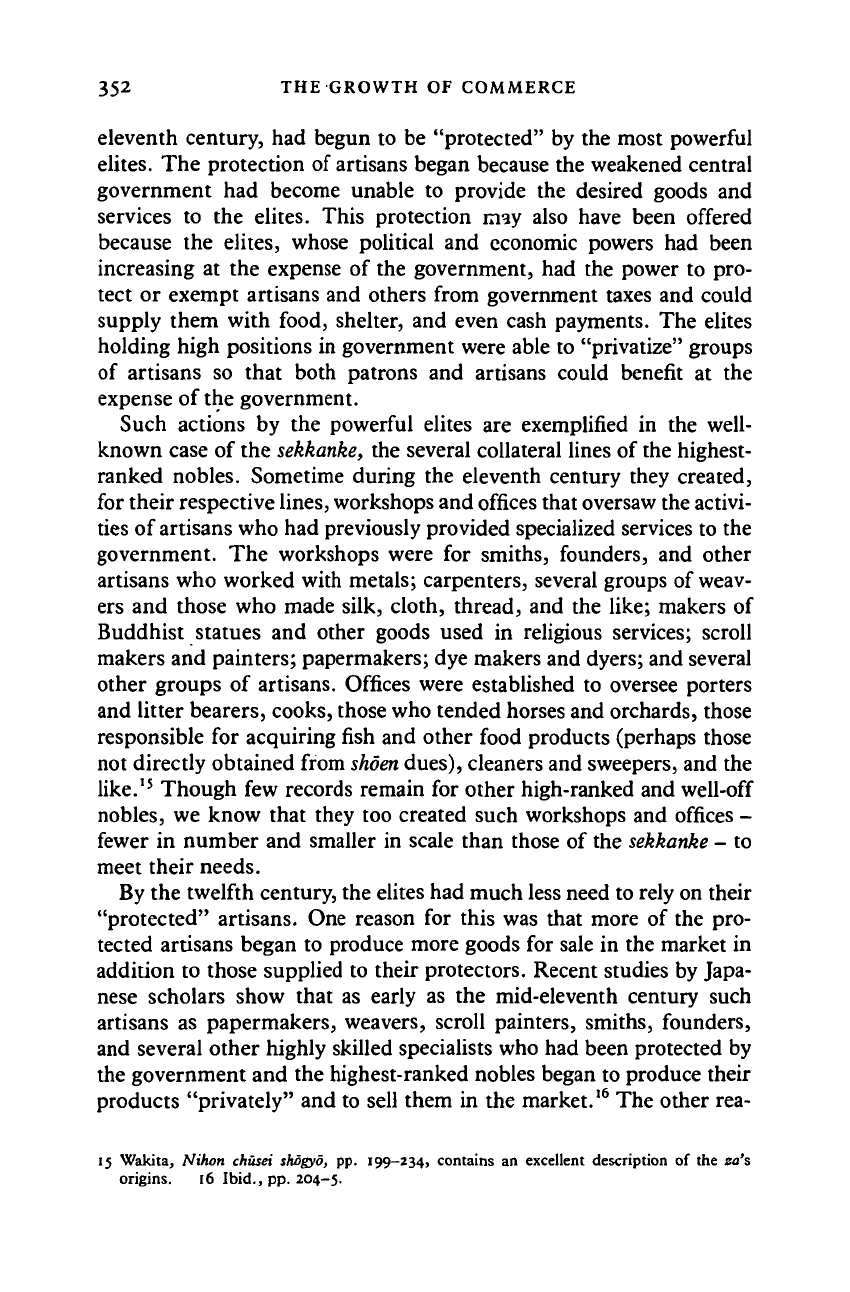
352 THE GROWTH OF COMMERCE
eleventh century, had begun to be "protected" by the most powerful
elites.
The protection of artisans began because the weakened central
government had become unable to provide the desired goods and
services to the elites. This protection may also have been offered
because the elites, whose political and economic powers had been
increasing at the expense of the government, had the power to pro-
tect or exempt artisans and others from government taxes and could
supply them with food, shelter, and even cash payments. The elites
holding high positions in government were able to "privatize" groups
of artisans so that both patrons and artisans could benefit at the
expense of the government.
Such actions by the powerful elites are exemplified in the well-
known case of the
sekkanke,
the several collateral lines of the highest-
ranked nobles. Sometime during the eleventh century they created,
for their respective
lines,
workshops and offices that oversaw the activi-
ties of artisans who had previously provided specialized services to the
government. The workshops were for smiths, founders, and other
artisans who worked with metals; carpenters, several groups of weav-
ers and those who made silk, cloth, thread, and the like; makers of
Buddhist statues and other goods used in religious services; scroll
makers and painters; papermakers; dye makers and dyers; and several
other groups of artisans. Offices were established to oversee porters
and litter bearers, cooks, those who tended horses and orchards, those
responsible for acquiring fish and other food products (perhaps those
not directly obtained from
shoen
dues), cleaners and sweepers, and the
like.
15
Though few records remain for other high-ranked and well-off
nobles, we know that they too created such workshops and offices -
fewer in number and smaller in scale than those of the
sekkanke
- to
meet their needs.
By the twelfth century, the elites had much less need to rely on their
"protected" artisans. One reason for this was that more of the pro-
tected artisans began to produce more goods for sale in the market in
addition to those supplied to their protectors. Recent studies by Japa-
nese scholars show that as early as the mid-eleventh century such
artisans as papermakers, weavers, scroll painters, smiths, founders,
and several other highly skilled specialists who had been protected by
the government and the highest-ranked nobles began to produce their
products "privately" and to sell them in the market.
16
The other rea-
15 Wakita, Nihon chusei shogyd, pp. 199-234, contains an excellent description of the za's
origins. 16 Ibid., pp. 204-5.
Cambridge Histories Online © Cambridge University Press, 2008
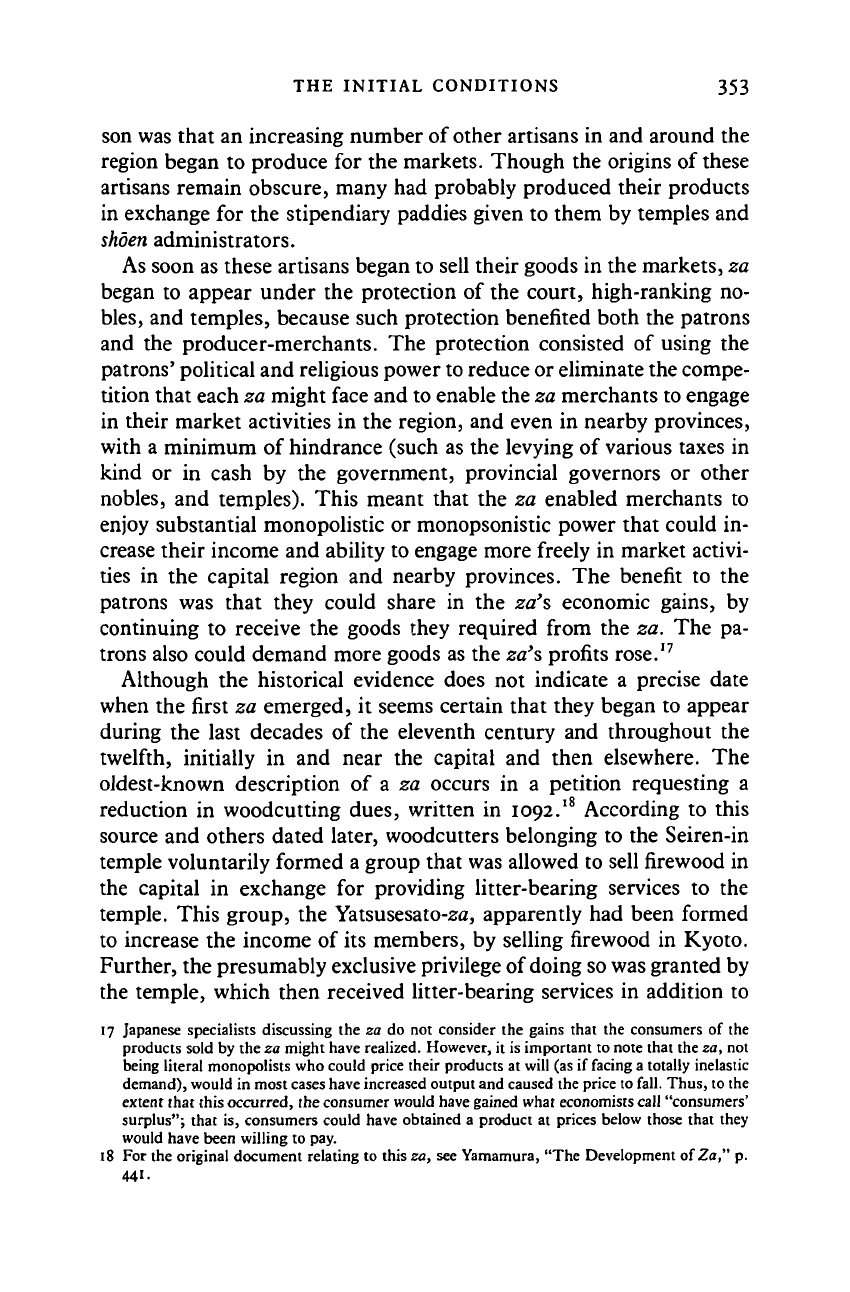
THE INITIAL CONDITIONS 353
son was that an increasing number of other artisans in and around the
region began to produce for the markets. Though the origins of these
artisans remain obscure, many had probably produced their products
in exchange for the stipendiary paddies given to them by temples and
shoen
administrators.
As soon as these artisans began to sell their goods in the markets, za
began to appear under the protection of the court, high-ranking no-
bles,
and temples, because such protection benefited both the patrons
and the producer-merchants. The protection consisted of using the
patrons' political and religious power to reduce or eliminate the compe-
tition that each za might face and to enable the za merchants to engage
in their market activities in the region, and even in nearby provinces,
with a minimum of hindrance (such as the levying of various taxes in
kind or in cash by the government, provincial governors or other
nobles, and temples). This meant that the za enabled merchants to
enjoy substantial monopolistic or monopsonistic power that could in-
crease their income and ability to engage more freely in market activi-
ties in the capital region and nearby provinces. The benefit to the
patrons was that they could share in the za's economic gains, by
continuing to receive the goods they required from the za. The pa-
trons also could demand more goods as the za's profits rose.
17
Although the historical evidence does not indicate a precise date
when the first za emerged, it seems certain that they began to appear
during the last decades of the eleventh century and throughout the
twelfth, initially in and near the capital and then elsewhere. The
oldest-known description of a za occurs in a petition requesting a
reduction in woodcutting dues, written in 1092.
l8
According to this
source and others dated later, woodcutters belonging to the Seiren-in
temple voluntarily formed a group that was allowed to sell firewood in
the capital in exchange for providing litter-bearing services to the
temple. This group, the Yatsusesato-za, apparently had been formed
to increase the income of its members, by selling firewood in Kyoto.
Further, the presumably exclusive privilege of doing so was granted by
the temple, which then received litter-bearing services in addition to
17 Japanese specialists discussing the za do not consider the gains that the consumers of the
products sold by the za might have realized. However, it is important to note that the za, not
being literal monopolists who could price their products at will (as if facing a totally inelastic
demand), would in most cases have increased output and caused the price to fall. Thus, to ihe
extent that this occurred, the consumer would have gained what economists call "consumers'
surplus"; that is, consumers could have obtained a product at prices below those that they
would have been willing to pay.
18 For the original document relating to this za, see Yamamura, "The Development of Za," p.
441.
Cambridge Histories Online © Cambridge University Press, 2008
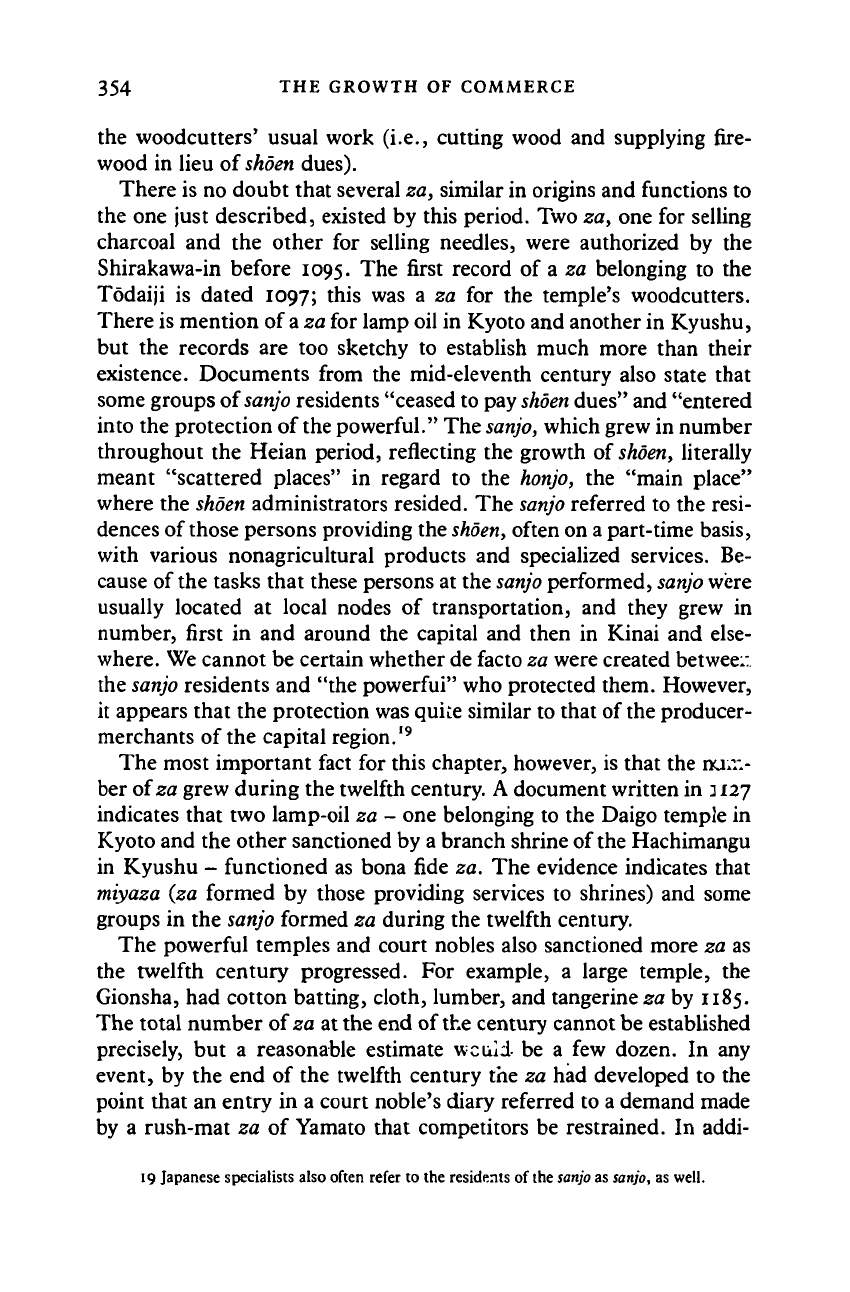
354 THE GROWTH OF COMMERCE
the woodcutters' usual work (i.e., cutting wood and supplying fire-
wood in lieu of
shoen
dues).
There is no doubt that several za, similar in origins and functions to
the one just described, existed by this period. Two za, one for selling
charcoal and the other for selling needles, were authorized by the
Shirakawa-in before 1095. The first record of a za belonging to the
Todaiji is dated 1097; this was a za for the temple's woodcutters.
There is mention of
a
za for lamp oil in Kyoto and another in Kyushu,
but the records are too sketchy to establish much more than their
existence. Documents from the mid-eleventh century also state that
some groups of
sanjo
residents "ceased to pay
shoen
dues" and "entered
into the protection of the powerful." The
sanjo,
which grew in number
throughout the Heian period, reflecting the growth of
shoen,
literally
meant "scattered places" in regard to the
honjo,
the "main place"
where the
shoen
administrators resided. The
sanjo
referred to the resi-
dences of those persons providing the
shoen,
often on a part-time basis,
with various nonagricultural products and specialized services. Be-
cause of the tasks that these persons at the
sanjo
performed,
sanjo
were
usually located at local nodes of transportation, and they grew in
number, first in and around the capital and then in Kinai and else-
where. We cannot be certain whether de facto za were created be
twee::
the
sanjo
residents and "the powerful" who protected them. However,
it appears that the protection was quite similar to that of the producer-
merchants of the capital region.
19
The most important fact for this chapter, however, is that the num-
ber of za grew during the twelfth century. A document written in
1127
indicates that two lamp-oil za - one belonging to the Daigo temple in
Kyoto and the other sanctioned by a branch shrine of
the
Hachimangu
in Kyushu - functioned as bona fide za. The evidence indicates that
miyaza (za formed by those providing services to shrines) and some
groups in the
sanjo
formed za during the twelfth century.
The powerful temples and court nobles also sanctioned more za as
the twelfth century progressed. For example, a large temple, the
Gionsha, had cotton batting, cloth, lumber, and tangerine za by 1185.
The total number of za at the end of the century cannot be established
precisely, but a reasonable estimate would- be a few dozen. In any
event, by the end of the twelfth century the za had developed to the
point that an entry in a court noble's diary referred to a demand made
by a rush-mat za of Yamato that competitors be restrained. In addi-
19 Japanese specialists also often refer to the residents of the sanjo as sanjo, as well.
Cambridge Histories Online © Cambridge University Press, 2008
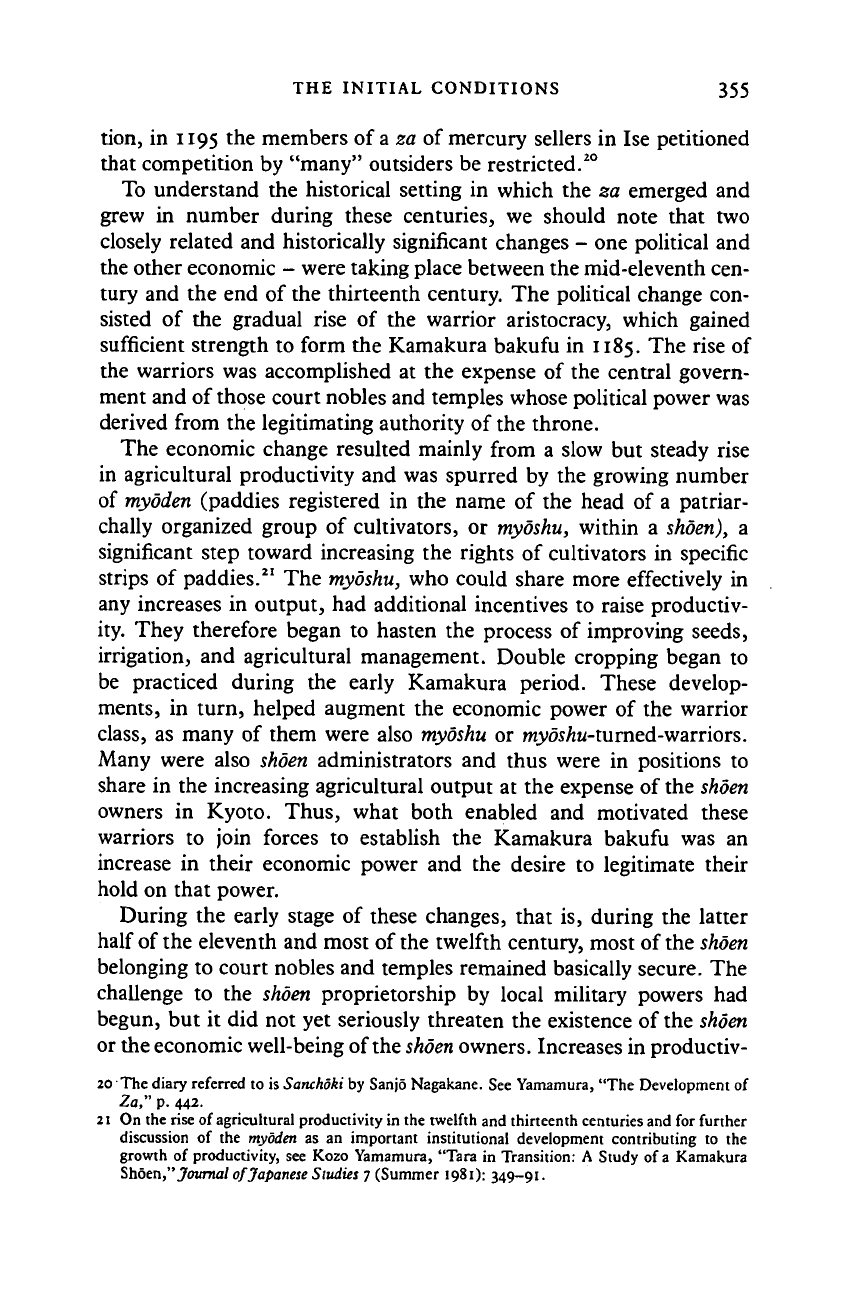
THE INITIAL CONDITIONS 355
tion, in 1195 the members of a za of mercury sellers in Ise petitioned
that competition by "many" outsiders be restricted.
20
To understand the historical setting in which the za emerged and
grew in number during these centuries, we should note that two
closely related and historically significant changes - one political and
the other economic - were taking place between the mid-eleventh cen-
tury and the end of the thirteenth century. The political change con-
sisted of the gradual rise of the warrior aristocracy, which gained
sufficient strength to form the Kamakura bakufu in 1185. The rise of
the warriors was accomplished at the expense of the central govern-
ment and of those court nobles and temples whose political power was
derived from the legitimating authority of the throne.
The economic change resulted mainly from a slow but steady rise
in agricultural productivity and was spurred by the growing number
of myoden (paddies registered in the name of the head of a patriar-
chally organized group of cultivators, or myoshu, within a shoen), a
significant step toward increasing the rights of cultivators in specific
strips of paddies.
21
The myoshu, who could share more effectively in
any increases in output, had additional incentives to raise productiv-
ity. They therefore began to hasten the process of improving seeds,
irrigation, and agricultural management. Double cropping began to
be practiced during the early Kamakura period. These develop-
ments, in turn, helped augment the economic power of the warrior
class,
as many of them were also myoshu or myoshu-turned-warriors.
Many were also shoen administrators and thus were in positions to
share in the increasing agricultural output at the expense of the shoen
owners in Kyoto. Thus, what both enabled and motivated these
warriors to join forces to establish the Kamakura bakufu was an
increase in their economic power and the desire to legitimate their
hold on that power.
During the early stage of these changes, that is, during the latter
half of the eleventh and most of the twelfth century, most of the
shoen
belonging to court nobles and temples remained basically secure. The
challenge to the shoen proprietorship by local military powers had
begun, but it did not yet seriously threaten the existence of the shoen
or the economic well-being of the
shoen
owners. Increases in productiv-
20 The diary referred to is Sanchoki by Sanjo Nagakane. See Yamamura, "The Development of
Za,"
p. 442.
21 On the rise of agricultural productivity in the twelfth and thirteenth centuries and for further
discussion of the myoden as an important institutional development contributing to the
growth of productivity, see Kozo Yamamura, "Tara in Transition: A Study of a Kamakura
Shoen," Journal of Japanese Studies 7 (Summer 1981): 349-91.
Cambridge Histories Online © Cambridge University Press, 2008
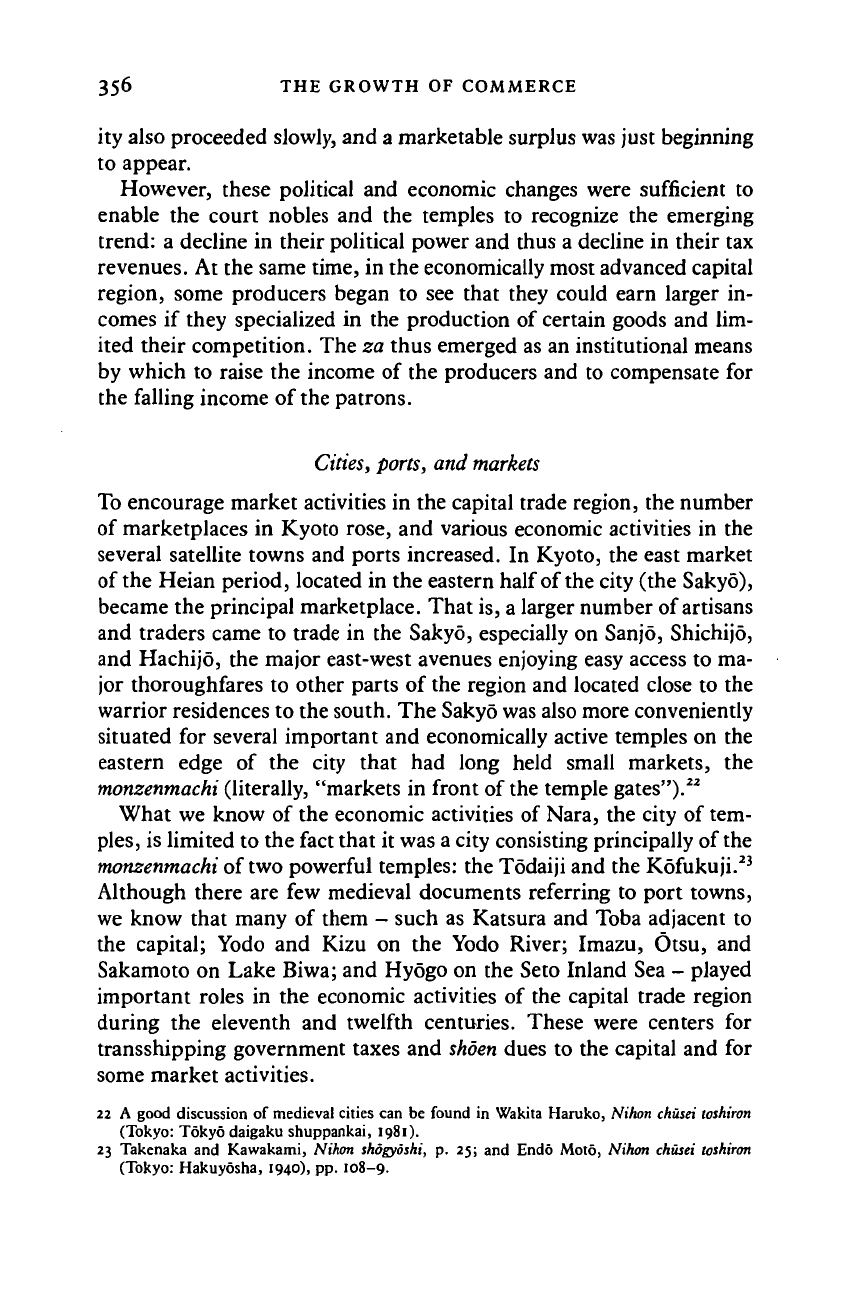
356 THE GROWTH OF COMMERCE
ity also proceeded slowly, and a marketable surplus was just beginning
to appear.
However, these political and economic changes were sufficient to
enable the court nobles and the temples to recognize the emerging
trend: a decline in their political power and thus a decline in their tax
revenues. At the same time, in the economically most advanced capital
region, some producers began to see that they could earn larger in-
comes if they specialized in the production of certain goods and lim-
ited their competition. The za thus emerged as an institutional means
by which to raise the income of the producers and to compensate for
the falling income of the patrons.
Cities, ports, and markets
To encourage market activities in the capital trade region, the number
of marketplaces in Kyoto rose, and various economic activities in the
several satellite towns and ports increased. In Kyoto, the east market
of the Heian period, located in the eastern half of
the
city (the Sakyo),
became the principal marketplace. That is, a larger number of artisans
and traders came to trade in the Sakyo, especially on Sanjo, Shichijo,
and Hachijo, the major east-west avenues enjoying easy access to ma-
jor thoroughfares to other parts of the region and located close to the
warrior residences to the south. The Sakyo was also more conveniently
situated for several important and economically active temples on the
eastern edge of the city that had long held small markets, the
monzenmachi
(literally, "markets in front of the temple gates").
22
What we know of the economic activities of Nara, the city of tem-
ples,
is limited to the fact that it was a city consisting principally of the
monzenmachi
of
two
powerful temples: the Todaiji and the Kofukuji.
23
Although there are few medieval documents referring to port towns,
we know that many of them - such as Katsura and Toba adjacent to
the capital; Yodo and Kizu on the Yodo River; Imazu, Otsu, and
Sakamoto on Lake Biwa; and Hyogo on the Seto Inland Sea - played
important roles in the economic activities of the capital trade region
during the eleventh and twelfth centuries. These were centers for
transshipping government taxes and
shoen
dues to the capital and for
some market activities.
22 A good discussion of medieval cities can be found in Wakita Haruko, Nihon
chusei toshiron
(Tokyo: Tokyo daigaku shuppankai, 1981).
23 Takenaka and Kawakami, Nihon shogyoshi, p. 25; and Endo Moto, Nihon chusei
toshiron
(Tokyo: Hakuyosha, 1940), pp. 108-9.
Cambridge Histories Online © Cambridge University Press, 2008
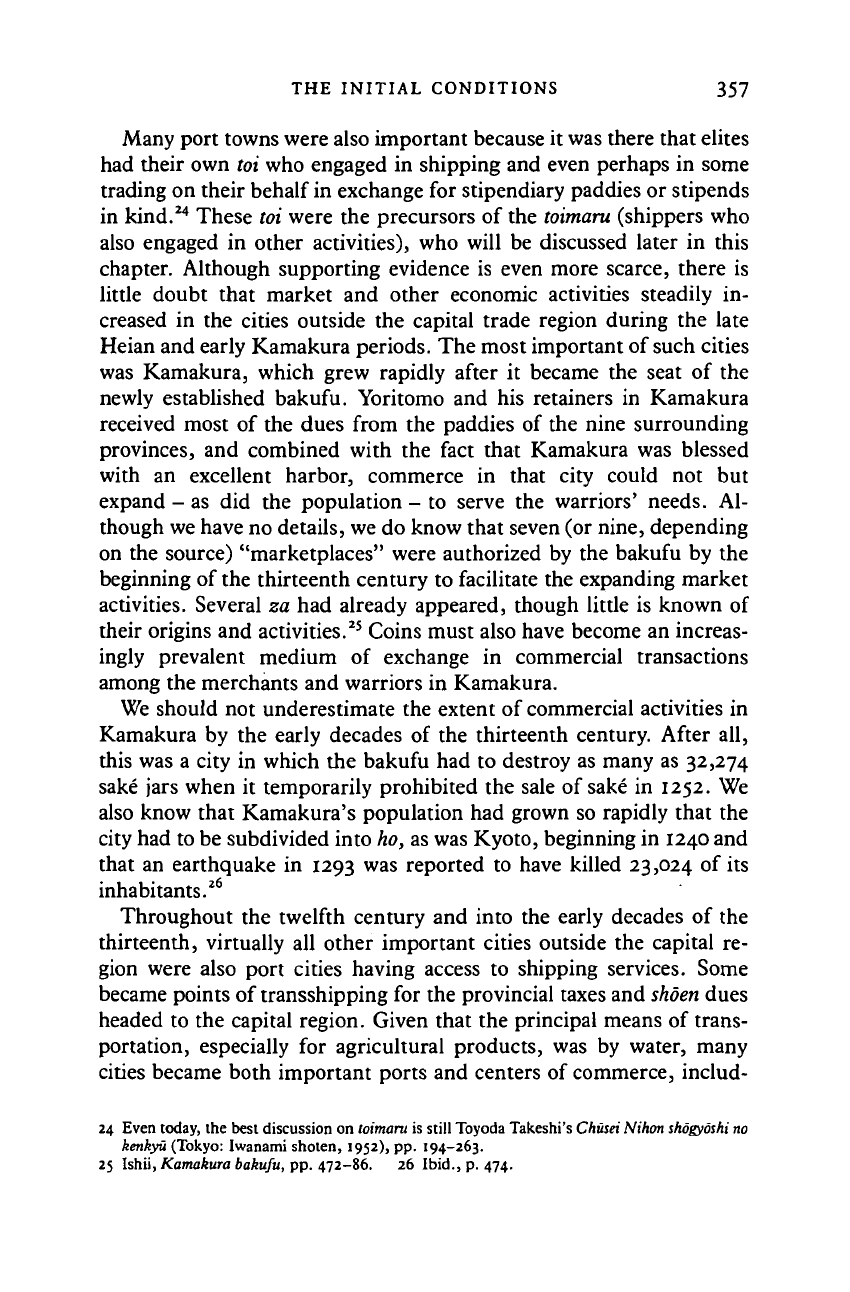
THE INITIAL CONDITIONS 357
Many port towns were also important because it was there that elites
had their own toi who engaged in shipping and even perhaps in some
trading on their behalf in exchange for stipendiary paddies or stipends
in kind.
24
These toi were the precursors of the toimaru (shippers who
also engaged in other activities), who will be discussed later in this
chapter. Although supporting evidence is even more scarce, there is
little doubt that market and other economic activities steadily in-
creased in the cities outside the capital trade region during the late
Heian and early Kamakura periods. The most important of such cities
was Kamakura, which grew rapidly after it became the seat of the
newly established bakufu. Yoritomo and his retainers in Kamakura
received most of the dues from the paddies of the nine surrounding
provinces, and combined with the fact that Kamakura was blessed
with an excellent harbor, commerce in that city could not but
expand - as did the population - to serve the warriors' needs. Al-
though we have no details, we do know that seven (or nine, depending
on the source) "marketplaces" were authorized by the bakufu by the
beginning of the thirteenth century to facilitate the expanding market
activities. Several za had already appeared, though little is known of
their origins and activities.
25
Coins must also have become an increas-
ingly prevalent medium of exchange in commercial transactions
among the merchants and warriors in Kamakura.
We should not underestimate the extent of commercial activities in
Kamakura by the early decades of the thirteenth century. After all,
this was a city in which the bakufu had to destroy as many as 32,274
sake jars when it temporarily prohibited the sale of sake in 1252. We
also know that Kamakura's population had grown so rapidly that the
city had to be subdivided into ho, as was Kyoto, beginning in 1240 and
that an earthquake in 1293 was reported to have killed 23,024 of its
inhabitants.
26
Throughout the twelfth century and into the early decades of the
thirteenth, virtually all other important cities outside the capital re-
gion were also port cities having access to shipping services. Some
became points of transshipping for the provincial taxes and
shoen
dues
headed to the capital region. Given that the principal means of trans-
portation, especially for agricultural products, was by water, many
cities became both important ports and centers of commerce, includ-
24 Even today, the best discussion on toimaru is still Toyoda Takeshi's Chusei Nihon
shogyoshi
no
kenkyu (Tokyo: Iwanami shoten, 1952), pp. 194-263.
25 Ishii, Kamakura bakufu, pp. 472-86. 26 Ibid., p. 474.
Cambridge Histories Online © Cambridge University Press, 2008
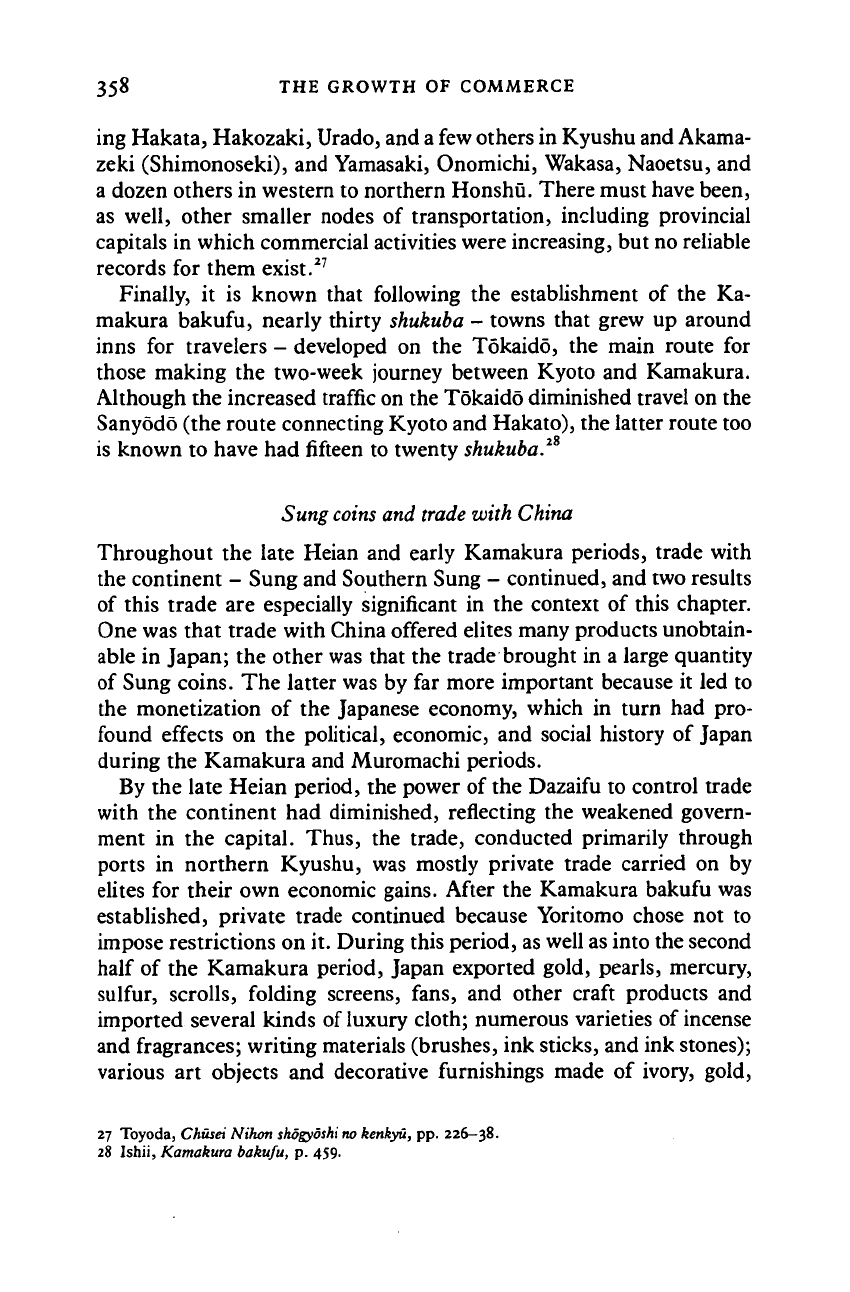
358 THE GROWTH OF COMMERCE
ing Hakata, Hakozaki, Urado, and
a
few others in Kyushu and Akama-
zeki (Shimonoseki), and Yamasaki, Onomichi, Wakasa, Naoetsu, and
a dozen others in western to northern Honshu. There must have been,
as well, other smaller nodes of transportation, including provincial
capitals in which commercial activities were increasing, but no reliable
records for them exist.
27
Finally, it is known that following the establishment of the Ka-
makura bakufu, nearly thirty
shukuba
- towns that grew up around
inns for travelers - developed on the Tokaido, the main route for
those making the two-week journey between Kyoto and Kamakura.
Although the increased traffic on the Tokaido diminished travel on the
Sanyodo (the route connecting Kyoto and Hakato), the latter route too
is known to have had fifteen to twenty
shukuba.
2
*
Sung
coins
and trade with China
Throughout the late Heian and early Kamakura periods, trade with
the continent - Sung and Southern Sung - continued, and two results
of this trade are especially significant in the context of this chapter.
One was that trade with China offered elites many products unobtain-
able in Japan; the other was that the trade brought in a large quantity
of Sung coins. The latter was by far more important because it led to
the monetization of the Japanese economy, which in turn had pro-
found effects on the political, economic, and social history of Japan
during the Kamakura and Muromachi periods.
By the late Heian period, the power of the Dazaifu to control trade
with the continent had diminished, reflecting the weakened govern-
ment in the capital. Thus, the trade, conducted primarily through
ports in northern Kyushu, was mostly private trade carried on by
elites for their own economic gains. After the Kamakura bakufu was
established, private trade continued because Yoritomo chose not to
impose restrictions on it. During this period, as well as into the second
half of the Kamakura period, Japan exported gold, pearls, mercury,
sulfur, scrolls, folding screens, fans, and other craft products and
imported several kinds of luxury cloth; numerous varieties of incense
and fragrances; writing materials (brushes, ink sticks, and ink stones);
various art objects and decorative furnishings made of ivory, gold,
27 Toyoda, Chusei Nihon
shogyoshi no
kenkyu, pp. 226-38.
28 Ishii, Kamakura bakufu, p. 459.
Cambridge Histories Online © Cambridge University Press, 2008
